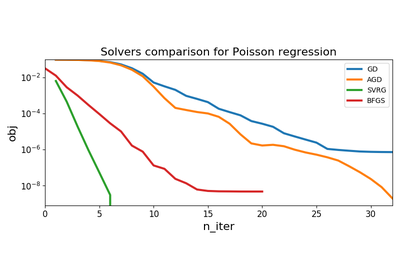tick.linear_model.PoissonRegression¶
-
class
tick.linear_model.PoissonRegression(step=0.001, fit_intercept=True, penalty='l2', C=1000.0, tol=1e-05, max_iter=100, solver='svrg', verbose=False, warm_start=False, print_every=10, record_every=1, elastic_net_ratio=0.95, random_state=None, blocks_start=None, blocks_length=None)[source]¶ Poisson regression learner, with exponential link function. It supports several solvers and several penalizations. Note that for this model, there is no way to tune automatically the
stepof the solver. Thus, the default forstepmight work, or not, so that several values should be tried out.- Parameters
step :
float, default=1e-3Step-size to be used for the solver. For Poisson regression there is no way to tune it automatically. The default tuning might work, or not…
C :
float, default=1e3Level of penalization
penalty : {‘l1’, ‘l2’, ‘elasticnet’, ‘tv’}, default=’l2’
The penalization to use. Default is ridge penalization
solver : {‘gd’, ‘agd’, ‘bfgs’, ‘svrg’, ‘sgd’}, default=’svrg’
The name of the solver to use
fit_intercept :
bool, default=TrueIf
True, include an intercept in the modelwarm_start :
bool, default=FalseIf true, learning will start from the last reached solution
tol :
float, default=1e-6The tolerance of the solver (iterations stop when the stopping criterion is below it). By default the solver does
max_iteriterationsmax_iter :
int, default=100Maximum number of iterations of the solver
verbose :
bool, default=FalseIf
True, we verbose things, otherwise the solver does not print anything (but records information in history anyway)print_every :
int, default=10Print history information when
n_iter(iteration number) is a multiple ofprint_everyrecord_every :
int, default=1Record history information when
n_iter(iteration number) is a multiple ofrecord_every- Attributes
weights :
numpy.array, shape=(n_features,)The learned weights of the model (not including the intercept)
intercept :
floator NoneThe intercept, if
fit_intercept=True, otherwiseNone
-
__init__(step=0.001, fit_intercept=True, penalty='l2', C=1000.0, tol=1e-05, max_iter=100, solver='svrg', verbose=False, warm_start=False, print_every=10, record_every=1, elastic_net_ratio=0.95, random_state=None, blocks_start=None, blocks_length=None)¶
-
decision_function(X)[source]¶ Decision function for given samples. This is simply given by the predicted means of each sample. Predicted mean in this model for a features vector x is simply given by exp(x.dot(weights) + intercept)
- Parameters
X :
np.ndarrayorscipy.sparse.csr_matrix, shape=(n_samples, n_features)Features matrix
- Returns
output :
np.array, shape=(n_samples,)Value of the decision function of each sample points
-
fit(X: object, y: numpy.array)[source]¶ Fit the model according to the given training data.
- Parameters
X :
np.ndarrayorscipy.sparse.csr_matrix,, shape=(n_samples, n_features)Training vector, where n_samples in the number of samples and n_features is the number of features.
y :
np.array, shape=(n_samples,)Target vector relative to X.
- Returns
self :
PoissonRegressionThe fitted instance of the model
-
get_params()¶ Get parameters for this estimator.
- Returns
params :
dictParameter names mapped to their values.
-
loglik(X, y)[source]¶ Compute the minus log-likelihood of the model, using the given features matrix and labels, with the intercept and model weights currently fitted in the object. Minus log-likelihood is computed, so that smaller is better.
- Parameters
X :
np.ndarrayorscipy.sparse.csr_matrix,, shape=(n_samples, n_features)Features matrix
y :
np.array, shape=(n_samples,)Labels vector relative to X
- Returns
output :
floatValue of the minus log-likelihood
-
predict(X)[source]¶ Predict label for given samples
- Parameters
X :
np.ndarrayorscipy.sparse.csr_matrix, shape=(n_samples, n_features)Features matrix
- Returns
output :
np.array, shape=(n_samples,)Returns predicted labels
-
set_params(**kwargs)¶ Set the parameters for this learner.
- Parameters
**kwargs : :
Named arguments to update in the learner
- Returns
output :
LearnerGLMself with updated parameters
